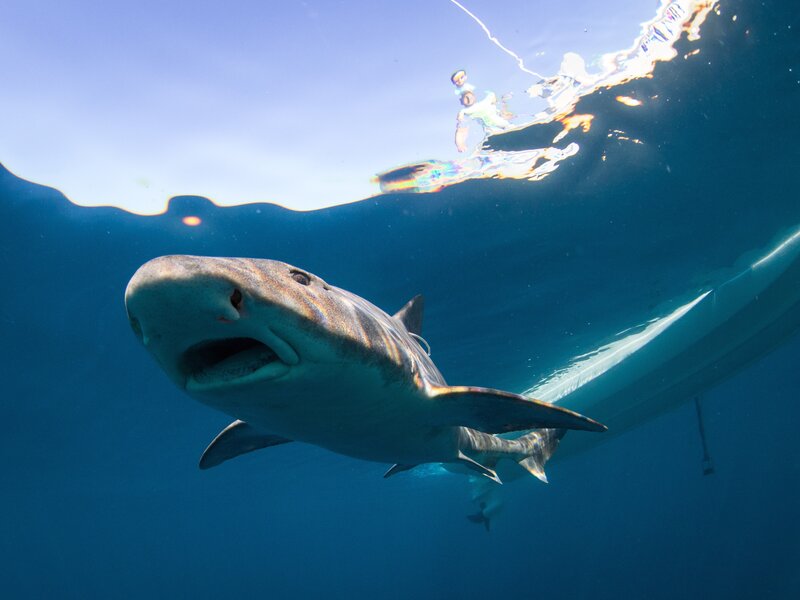Leopard sharks find their way with their noses, say scientists
Loading...
Forget Google Maps – these sharks get directions from their noses.
A recent study led by Andrew Nosal, a postdoctoral researcher at Scripps Institution of Oceanography and the Birch Aquarium, found that scent could be an important navigational tool for leopard sharks.
In a controlled experiment, sharks with unimpaired olfaction were able to swim back to their coastal habitats more efficiently than their scent-compromised counterparts. Dr. Nosal and colleagues published their findings Wednesday in the journal PLOS ONE.
Leopard sharks favor coastal waters and enclosed bays, but are capable of swimming to distant ocean sites with remarkable efficiency, often following nearly straight routes. But until now, it was unclear what force was guiding them.
“We were not necessarily surprised to find that this remarkable navigation ability is mediated by smell, at least in part,” Nosal says. “Sharks were already known for their keen sense of smell, and we knew other animals use smell for navigation, such as salmon, birds, and insects. It had simply not been experimentally demonstrated for sharks in the open ocean until now.”
To test this hypothesis, researchers captured 25 leopard sharks near the shoreline and released them more than 5 miles offshore. Roughly half the sharks had their sense of smell temporarily impaired (by stuffing petroleum-jelly-soaked cotton wool into the shark's nostrils). Nosal and colleagues then tracked each shark’s return journey using acoustic technology.
On average, control sharks ended up 62.6 percent closer to shore after four hours. By comparison, impaired sharks only made it 37.2 percent closer to shore. The unimpaired sharks also took significantly more direct routes than the impaired sharks.
“We were amazed by the sharks’ ability to navigate back to shore – along nearly straight paths, no less – after being taken from their home, just outside the surf, and released in unfamiliar and hostile territory in the middle of the open ocean. Even sharks that happened to swim away from shore initially made corrective U-turns within 30 minutes of release.”
But while it’s clear that scent is an important navigating tool for these sharks, researchers are still tracking down the specific mechanisms at work.
“We did not determine what exactly the sharks were smelling, but they were likely able to detect and respond to various chemical gradients that run perpendicular to shore,” Nosal says. “Along the coast, productivity is high – meaning lots of life – due to upwelling, which is the process that brings cold, nutrient-rich water to the surface and fuels plankton growth.”
“This is why seawater off California is often a greenish color close to shore, but becomes increasingly clear as you move offshore,” he adds. “Thus, we suspect the sharks are smelling something associated with productivity. For example, they may be detecting dissolved amino acids, the building blocks of proteins. The concentration of dissolved amino acids would increase with proximity to shore due to higher productivity there.”
Other fish have the ability to detect productivity – salmon, for example, can home in on dissolved amino acids in river water – so it’s possible that sharks could do the same. Leopard sharks might also be following a compound called dimethyl sulfide, which is also associated with high productivity.
“Planktivorous sharks, including basking and whale sharks, are believed to cue into dimethyl sulfide gradients to locate plankton blooms on which to feed,” Nosal says. “There is no reason to think sharks could not use dimethyl sulfide gradients to navigate more generally.”
Many shark behaviors, like feeding, use multiple senses in tandem. So while smell is certainly important to shark navigation, it is most likely not the only sense at work.
“Even the movements of sharks with their sense of smell blocked were biased toward shore, suggesting other senses also play a role,” Nosal explains. “These could include hearing low-frequency sounds emanating from crashing waves or detecting geomagnetic fields.”
But further research will be necessary to determine how these senses are integrated hierarchically, Nosal says.
“Which senses are most important?” Nosal wonders. “Which senses are backups to other senses? This will also require more fieldwork and controlled laboratory studies.”






